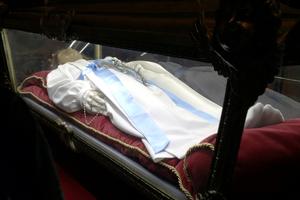Now More Than Ever, St. Maria Goretti Is a Sign of Contradiction
SAINTS & ART: St. Maria Goretti remains a relevant saint for today’s young people tempted by the same sources that helped set her murderer on his ‘ruin’

St. Maria Goretti (1890-1902) was unusual at the time of her canonization and remains — as holiness always is — a sign of contradiction today.
She was canonized in 1950. Until St. John Paul II’s effort to demonstrate the holiness to be found in our own times through his efforts to canonize the saints — and numerous martyrs — of the 20th century, sainthood was rarely recognized until centuries after the candidate’s death. That Maria’s mother was present at her canonization 48 years after her death was hitherto unprecedented.
As for her relevance — and how she contradicts our times — more later.
Maria was born Oct. 16, 1890, in Corinaldo, a village in east central Italy, one of seven children of farmers. By 1895, the family lost its farm, moving further towards Rome to become what Americans might call tenant farmers, i.e., farm laborers working for somebody else. By 1899, they occupied a house together with another family, the Serenellis, and Maria’s father died.
The mother and family continued on as farm laborers. Maria would often stay at home to watch the youngest child and tend to domestic responsibilities. On July 5, 1902, she was at home with Alessandro Serenelli, the 20-year-old son of the family with whom the Gorettis occupied the house. Serenelli threatened to attack her if she did not submit sexually to him. She refused, calling it a sin. He began choking her, then stabbed her 14 times, injuring her upper body (throat, heart, lungs, diaphragm). She was taken to a regional hospital where doctors operated with anesthesia, but she died the next day. Before she expired, she declared that she forgave her attacker.
Serenelli was immediately arrested and sentenced to 30 years’ imprisonment. Stubbornly unrepentant, he changed after three years and a visit from a local bishop, to whom he later confided that he had seen Maria in a dream, bearing lilies in her hand, flowers that burned in his. He was released in 1929, returned to Maria’s mother to beg forgiveness, became a porter as a lay brother in the Capuchins, and died in 1970.
When Pius XII canonized Maria, many young women attended the ceremony, which was also an opportunity to reaffirm the value of chastity in young peoples’ lives.
Though that motif had been strong in the first decades after Maria’s canonization, it seems to have waned in some circles. That leads me to the issue of how Maria remains a “sign of contradiction” although less than a century and a quarter separate us from this saint.
First, because she was a victim of assault due to attempted rape, some would like to diminish the sexual element. Maria was a victim of violence, assault, crime — and a child victim at that! That’s true, and that focus is increasingly relevant in our day as crime rates escalate, especially in poorer neighborhoods.
But one cannot overlook the sexual motive that fired that violence. Some ideologues would limit “sex” to consensual intercourse — Maria vehemently rejected Serenelli — and so downplay the sexual in this attempted sexual assault. But hers was not a robbery or a random act of violence: even Serenelli writes it was a “crime of passion” and so the sexual element should not be diminished. Indeed, given the scandalous escalation of crimes of sexual abuse against minors in the world and also of vulnerable people (like seminarians) in the Church, Maria can very much be a patroness of young victims of sexual abuse (although perhaps a boy would be a more appropriate patron).
Second, our day has recognized that women who are victims of rape are often forced into sexual submission against their wills and — although she was a young girl — Maria is a fitting patroness for these people.
Third, Maria represents the vulnerabilities that the poor often endure, crimes less frequent elsewhere, like the gated communities of the privileged. Maria’s family was trying to survive as widows and orphans, and Serenelli lived under the same roof with them. The natural vulnerabilities of such situations imposed by poverty should not be overlooked and so Maria is also a fitting patron of the young living in poverty and hard conditions.
Lastly, Maria died defending her purity as a natural right and a supernatural duty. (This does not detract from rape victims forced into sexual submission.) Maria recognized that chastity was the normal vocation of a Christian outside of marriage.
The question we need to ask ourselves is why does a loss of that sense of chastity affect many girls of Maria’s age and older today?
For Maria, chastity was not just a “choice,” it was a duty. It was part of her relationship to God. We have no indication that Maria intended a religious life; her reaction was the normal response of a Catholic girl of her age and times: chastity is what living the kind of life God wants of me at this station of life is.
Sociologists and others may offer all sorts of explanations about “social development” and “prolonged adolescence” and “changed sexual mores” to explain our contemporary situation, but perhaps the question to pose to Catholic pre-teens and teens today is what did Maria see so clearly they don’t necessarily?
There is some suggestion that Serenelli may have used pornography. In his deathbed letter, he speaks of his behavior being “influenced by print, mass media, and bad examples which are followed by the majority of young people without even thinking.” This may have been a 1970s way of indirectly speaking of pornography. Given the proliferation of pornography, especially involving the young, as well as grooming introduced into schools under the guise of “sex education” and “acquaintance with different lifestyles,” Maria Goretti again remains a relevant saint for today’s young people tempted by the same sources that helped set her murderer on his “ruin.”
Today’s painting is by Italian artist Giuseppe Brovelli-Soffredini (d.1936). It depicts a young girl about Maria’s age. The dominant colors, but for her flowing locks of brown-red hair, are white (“the white robes of the Lamb” and white as the color of purity) and blue (a sign of heaven). I do not have a date for the painting. However, among the other unusual things about the modern-day Saint Maria Goretti is that she already lived in an age of photography, you can compare her sole surviving photograph with the artist’s work.
- Keywords:
- st. Maria goretti
















